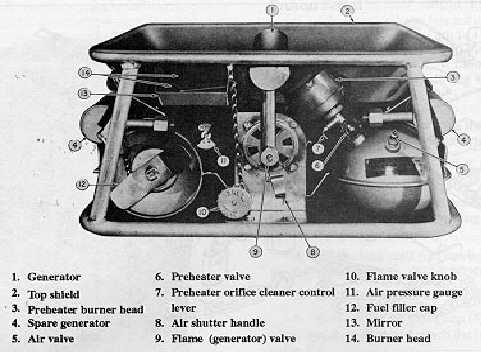| |
90.91
Figure 11-10.—Burner unit and parts.
monoxide poisoning. The outfit is divided into two
sections that weigh about 40 pounds each and is
easily carried on two backboards. A 5-gallon can
that completes the necessary equipment may be
carried on a third packboard.
The immersion-type heater is designed for use
with corrugated cans and tank trailers. It is used
primarily to heat water for washing and
sanitizing dinnerware and cooking utensils in the
field. It is designed to heat water in either 24- or
30-gallon corrugated cans.
In cold climates, the heater can be used for
melting snow or ice into water. It also can keep
existing water supplies from freezing. In extreme
emergencies, the heater may be used to heat a
tent or other shelter, provided the exhaust fumes
are piped out of the enclosed space.
Gasoline is the prescribed fuel. Although
kerosene, diesel oils, and fuel oils may be burned
in the heater, they produce more smoke and
require a longer preheating period. A full tank of
gasoline (2.2 gallons) should run the heater for 6
hours under normal operating conditions.
However, if operated continuously at a high-fire
rate, a tank of gasoline may be consumed in less
than 4 hours.
The tank trailer water heater is designed for
use in cold climates to keep water supplies from
freezing. It is used to heat water in 250- and 400-
gallon water tank trailers and in a 700-gallon
water tank truck. With the same provisions as
the immersion-type heater, it also can be used in
emergencies to heat a tent or other personnel
shelter. Fuel requirements and capabilities of the
heater are same as those of the corrugated can
heater.
The Army TM, Basic Doctrine for Army Field
Feeding, FM 10-23, contains the minimum
information necessary to safely operate the
immersion-type heater. Be sure you receive a
copy of the TM with the immersion heater.
IMPROVISED STOVES
Any large metal container, such as a washtub,
can be easily made into a stove. It is only
necessary to provide an opening for tending to the
fire and the bottom draft and to make a chimney
at the top. A tin can with both ends removed
makes a good chimney.
You can make a surprisingly efficient gasoline
stove by using two cans. Pierce the outer empty
can, preferably a No. 10 can, with nail holes. This
is done from the top sides down to within about 1
1/2 inches from the bottom. Next, put clean sand
into the can filling it up to the level where the
holes begin. Then saturate the sand with
gasoline. There should be no liquid gasoline
visible on top of the can.
11-10
|

